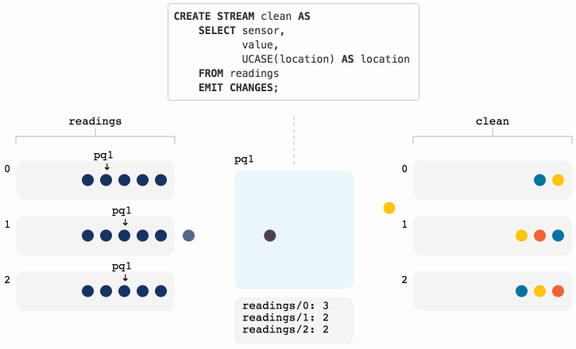Ahorra un 25 % (o incluso más) en tus costes de Kafka | Acepta el reto del ahorro con Kafka de Confluent
A (Stream Processing) Recipe for Thankfulness
Earlier this year, we introduced Stream Processing Use Case Recipes to help folks tackle real-world use cases through Apache Kafka® and ksqlDB quickstarts and tutorials. These recipes cover a wide range of topics and industries, ensuring that there’s something for almost everyone!
Today we’re introducing a new recipe that covers another common use case: survey response analysis. And to honor the upcoming US holiday, it just made sense to make this recipe Thanksgiving-themed.
If you’ve ever found yourself needing to analyze survey responses in real-time so that your company could make a well-informed decision––or if you’re trying to bake a last-minute pie for Friendsgiving that will appeal to as many people in your friend group as possible––then this use case recipe is for you!
Read on to see how this recipe for real-time survey analysis comes together and how you, too, can bake up something sweet!
From the recipe book
“Please rate your service with us today.”
“How likely are you to recommend us to a friend?”
Regardless of the questions being asked or who the target audience is, surveys are an opportunity for businesses to connect with their customers, users, and employees to get a better idea of how they’re doing on the whole. The data and insights that can be collected through a simple survey are endless.
It should come as no surprise that survey responses, like many other datasets, are more valuable when analyzed closer to when they’re recorded. Insights from a survey can go stale, and the responses themselves have the potential to lose value the longer they sit around waiting to be analyzed. Think about it: If your customer had a poor experience with your product or service, you’d want to know about it as soon as possible–it’s one of the reasons you’d implement a feedback survey in the first place. But that immediate feedback is practically useless if it’s analyzed hours or even days after the interaction. Wouldn’t it be better to understand and, more importantly, act on the survey responses in real time?
Preheat the oven
Before we dive into any baking, it’s always a good idea to make sure that your environment is set up properly. In this case, that means having a Confluent Cloud account and ksqlDB cluster ready to go.
Ingredients
For this recipe, we need some data to serve as input. Now, there are a ton of different ways that your business could be gathering survey results, so we won’t dive too much into the implementation details. For now, it’s safe to assume that the survey results are being collected and kept in some sort of data store.
When we need to move data from a data store into Kafka, your first thought should be to use a Kafka Connect Source Connector. In the context of data ingestion, Kafka Connect is a configuration-driven tool that programmatically polls data sources and writes data into Kafka.
If we were running an internal employee survey through ServiceNow, for example, the survey results and information on the respondents might be stored in a couple of ServiceNow tables. To get that data into a Confluent Cloud Kafka cluster, use the fully-managed ServiceNow Source Connector.
If you don’t have a dataset to use just yet, don’t worry. The recipe offers up some convenient sample data that you can insert directly into a Kafka topic using ksqlDB later on.
Instructions
If you’d like to follow along, the survey analysis recipe has everything you need to bring all of the ingredients together. Or, you can read on for a summary of how it happens.
That’s a pretty good recipe. But how do we make it even better?
Adjust to taste
If you’ve ever followed a recipe at home, you probably know that most recipes are more or less loose guidelines. As long as you follow the basic gist of it, you generally have some flexibility to add and mix new flavors to suit your tastes. It’s exactly the same with these stream processing use case recipes.
With that in mind, I had some ideas for how to spice up this survey analysis recipe and make it useful for me personally.
I’m an avid baker–from sourdough to pastries and everything in between, I love trying new recipes and baking up treats for friends and family. But as the holiday season approaches, I have a problem… What kind of pie(s) should I make for Thanksgiving to appeal to the most people?
Off to the farmer’s market
Because we all know that every recipe is better with farm-fresh produce, the biggest change I made to the recipe was where I got my data. In the past, if I wanted to poll my friends for their preferences on anything, I’d reach out to each of them individually and ask. But that’s boring and inefficient.
Inspired by the recipe, and knowing that there are no shortage of questions that I could use to poll my friends, I created an interactive survey-issuing bot using Telegram. This survey bot takes the place of a connector in my pipeline and writes data directly to Kafka for me. All of my survey questions are maintained in a Kafka topic for the Telegram bot to consume. From there, my friends can view and respond to the surveys on their phones through a conversation with the Telegram bot.
When my friends are done responding to the survey, the information is collected, formatted nicely according to a schema, and produced back into Kafka using a bit of Python. And of course, with the survey response data in Kafka, I’m exactly where the original recipe starts off, and I can dive right into the analysis.
If you�’re curious to learn more about the bot, take a look at the project on GitHub.
Serving it up, real time
All that’s left to do is issue the Thanksgiving pie survey and the pipeline I built will do the rest! As soon as their responses flow into Kafka, I can monitor the results in real time and view the aggregate results to see what pies my friends prefer.
And all that adds up to some very tasty pies at my next Friendsgiving!
Conclusion
As this blog post illustrates, Stream Processing Use Case Recipes are a great way to dive into the world of stream processing. They provide a solid foundation for you to expand on a variety of common use cases and make them your own. Even if you’re not a chef, it doesn’t take much effort to start with a plain recipe for real-time survey analysis and dress it up into a fun Telegram application that an entire friend group can be thankful for.
For more on Apache Kafka and its fun applications, take a look at the following resources:
¿Te ha gustado esta publicación? Compártela ahora
Suscríbete al blog de Confluent
A Guide to Stream Processing and ksqlDB Fundamentals
Event streaming applications are a powerful way to react to events as they happen and to take advantage of data while it is fresh. However, they can be a challenge […]
How Real-Time Stream Processing Works with ksqlDB, Animated
ksqlDB, the event streaming database, is becoming one of the most popular ways to work with Apache Kafka®. Every day, we answer many questions about the project, but here’s a […]

